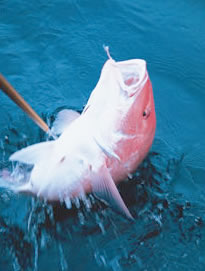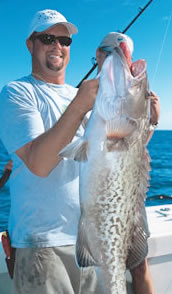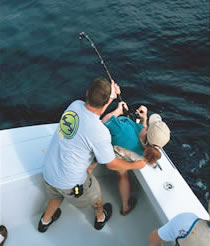September 19, 2012
By Larry Kinder
The published numbers are pretty good, but some of the best snapper and grouper fishing is off the charts.
 Paul Martin caught this 32-pound gag grouper on a live pinfish in 80 feet of water out of Port Canaveral.
Paul Martin caught this 32-pound gag grouper on a live pinfish in 80 feet of water out of Port Canaveral.
All the right ingredients for great snapper and grouper fishing converge just about due east of Daytona Beach, Florida. Up here you have lots of structure, a good variety of species and enough open ocean to spread out and avoid traffic.
Depending on who you travel with, you might have the final and probably most important ingredient, that bookful of GPS or loran numbers.
Don't get me wrong: There are some terrific public reefs in this area, and at times they hold their share of fish. Since 1970, the Ponce DeLeon Inlet Port Authority (under various names) has been deploying all sorts of structure offshore. There are old ships, barges, bridge rubble, telephone poles, culverts and more, in 65 to 80 feet of water. Over time, corals and other invertebrates cover these structures, and they become attractive to small fish and crustaceans. Amid mostly featureless, sandy bottom, the manmade reefs offer shelter and food for bottom-hugging grouper and snapper.
You can find latitude and longitude coordinates for these and more reefs on commercial charts, via the Internet and through other sources. After you've explored sites like these, though, the logical next step is looking farther offshore, to deeper natural structure.

Red snapper are a dime a dozen at the best numbers, often deep natural ledges.
|
Probably no one in this area has a book as coveted as that of Capt. John Lloyd, captain of the 46-foot
Triple Header. Lloyd has been a charter captain for over 20 years; his family has been fishing out of Ponce Inlet since the 1930s. He has numbers for little spots in deep water that no one else has. He's found many of them in the same way a new angler might: hunting around with sonar while trolling, exploring the perimeter of known sites, conferring with trusted sources. He's just been doing it a lot longer than most of us.
Early one morning, I watched while Lloyd pored over a gnarly notebook that looked to have been left to him by an early member of that family clan. Meanwhile, the mate was busy readying stout rods with 4/0 reels, gathering lead weights, sharpening hooks and jigs, and tending to frozen bait, a mixture of squid, herring, sardines and chunks of bonito.
We were getting set for a trip out of the Fishin' Store, where many of the charterboats in this area dock.
We soon departed. On our way to the fishing grounds, we stopped to catch live bait with sabiki rigs at a place where birds were diving on baitfish flickering on the surface. What followed looked like a fire drill as the mate scurried between anglers removing baitfish and placing the livies in the livewell in a corner of the cockpit. Occasionally, he paused to replace a sabiki rig cut by a kingfish or barracuda (note to self: light spinning rod and a flashy jig on a trace of wire would be heaps of fun here). Soon, more than a hundred small herring, blue runners, pinfish, pilchards and grunts shared the circular livewell.

Load up on live bait with sabiki rigs.
|
With sufficient bait, we continued our eastward trek. A little more than an hour after clearing the bell-buoy at Ponce Inlet, we were in water just over 200 feet deep. Lloyd slowed the
Triple Header to idle and precisely maneuvered into position. “Drop ‘em,” he called out from the bridge.
Simultaneously, we lowered our lines and five 12-ounce lead sinkers plummeted toward the rocky ledge. We were careful to control the speed of the descent so we did not overrun the spool. Almost immediately, the bite was on.
The ledge we were fishing is one of many along this part of the coast, remnants of geologic change long ago. As you move offshore along the upper Florida Atlantic coast, the continental shelf does not drop steadily to abyssal depths, but does so in intervals. Initially, the bottom is smooth and drops gradually for a few miles until you reach a ledge. Along the ledge, the bottom is irregular with jagged crevices and undercut ledges that parallel the coastline. Beyond the ledge, the bottom is again smooth but drops more rapidly this time for several more miles until yet another irregular ledge appears. Beyond this second ledge, the bottom is once again smooth and falls off even more steeply into the depths. The ledges offer bottom species hiding places for security and an area from which to ambush smaller baitfish and crustaceans, as well as a break from fighting the Gulf Stream currents. Between Port Canaveral and Ponce Inlet, ledges like these run roughly along the 21- and 27-fathom curves. A 28-fathom ledge runs off Ponce Inlet, as well.

Large gag grouper, or grays, earn top bragging rights.
|
Oculina coral reefs are a unique feature in the area, mostly between 200 and 300 feet of water, about 25 miles offshore. Composed of fragile, branching deepwater corals, the reef system ranges from 60 to 100 feet high in some spots. These particular coral formations have not been observed anywhere else in the continental United States. Stretching from Fort Pierce to Daytona Beach, the Oculina reef contains a complete ecosystem with thousands of various marine animals ranging from worms to crabs to shrimp to fish. Over 70 species of fish frequent the reef, including various grouper (gag, scamp, snowy, speckled hind, red and warsaw), snapper (red, vermilion, mangrove and lane), amberjack, bar jacks, triggerfish and porgies. The system is a prime spawning ground for gag and scamp grouper. South of Port Canaveral, much of the Oculina region has been closed to trawling, anchoring and all manner of bottom fishing, partly to offset years of abuse, and partly to protect some delicate research projects in the area.
In its northernmost reaches between Port Canaveral and Ponce Inlet, the Oculina reef begins to diminish in size and has no protection. The signature spikes of the now-intermittent reef are referred to as “The Cones” by anglers out of Canaveral and as “The Steeples” by anglers out of Ponce. Like ledges along the continental shelf, these spikes are fish magnets because of the food chain present.
Ocean currents in this area contribute to outstanding bottom fishing. In South Florida, the Gulf Stream flows northward, paralleling the coastline. In Central Florida, the Stream encounters a cape jutting out just north of Port Canaveral and the fast-flowing river in the sea is deflected to the northeast. A look at Florida's coastline north of the cape shows that it pulls away toward the northwest. With the Gulf Stream and coastline suddenly moving away from one another, a bit of an eddy is created in this area. Objects previously suspended in the water column and which had been pushed along by the stream's strong currents can now settle to the bottom in this eddy. Small baitfish and other marine creatures get a respite in the slower currents and have a much easier time maintaining their position near the various types of structure found in the area. The decreased offshore currents north of the cape make the area between Port Canaveral and Ponce Inlet unique along Florida's east coast and enhance what is already prime habitat for bottom fish.
“Bring ‘em up,” Lloyd commanded.

There's no mistaking an amberjack hookup. They pull like the dickens and sometimes it takes two people to boat one. These fish are abundant on deep reefs off Northeast Florida.
|
The bite that had been quite strong when we first dropped our lines had started to slow. We had placed three red snapper—releasing a couple of shorts—as well as two back-wrenching amberjack into the fishbox. Because we were fishing in water over 200 feet deep, we carefully vented the under-size snapper before releasing them. We could have probably caught a few more fish if we had stayed longer, but Lloyd had selected a dozen nearby spots from his notebook of numbers and hoped they, too, had bounty on the bottom waiting to be revealed. When the lead had cleared the gunnels and the rods safely stowed, he pushed the throttle forward and we moved to the next site.
Lloyd did a bit of jockeying with the boat as he checked how the 1.2 knots of northerly current and 8 mph of east wind were going to affect our drift. When the boat was properly positioned, we again dropped our lines. Rather than set an anchor in such deep water and then lose valuable time retrieving it if the area was not productive, Lloyd closely monitored the depthfinder and “bumped” the engines into gear from time-to-time, to keep us in position over our target. A gag grouper of about 25 pounds was the first fish to seize our bait. We initially thought the beast was strapped to the structure below as it refused to be moved off the bottom. A deeply bent rod and a strong back finally convinced it otherwise. Later, we landed a smaller gag, several nice red snapper and two more amberjack.
We had similar success at most of the spots we stopped at. On the way back to the dock, we made a final drop at a site that yielded a dozen vermilion snapper and a few triggerfish before they wised up to the small chunks of cutbait we were sending down to them. Tired, with muscles aching from the earlier brawls, we called it a day.
FS
First Published Florida Sportsman July 2006
By Larry Kinder
A Few East Central Florida Reefs
Port Authority Site 5 . . . . .29-07.19'N; 80-48.23'W . . . .65 feet
Liberty Ship Mindanao . . .29-12.00'N; 80-44.86'W . . . .80 feet
Intruder Airplanes . . . . . . .29-21.25'N; 80-21.74'W . . . .135 feet
Advertisement
Steeples (North) . . . . . . . .29-13.40'N; 80-10.00'W . . . .216 feet
Source: Provided by Florida Sportsman Fishing Chart No. 03
